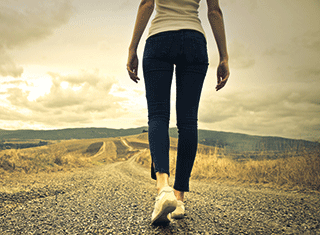Walk this way

We take a look at the health benefits of walking and how to get started
It’s springtime and many of us will want to start making the most of the brighter weather and kinder temperatures. What better way to do this than by going for a brisk walk in the outdoors?
“It is so often easy to forget about the many benefits of walking,” says Lorna Harris from the charity Living Streets (www.livingstreets.org.uk) which organises National Walking Month. “It’s one of the easiest things you can do to improve your health and wellbeing as well as one of the cheapest and easiest forms of exercise to build into your day.”
The Department of Health recommends that adults should aim to be active daily, suggesting at least 150 minutes of moderate intensity activity in bouts of 10 minutes or more throughout the week. Walking is one of the easiest ways to achieve these targets.
“Research repeatedly shows that walking not only helps us to maintain a healthy weight and keep well but reduces the risk of chronic conditions such as coronary heart disease and type 2 diabetes in the future,” says Lorna. “A recently published study by Cambridge University found that walking just 20 minutes a day can reduce your risk of an early death by almost a third. Even people who are significantly overweight or obese will reduce their risk.”
“A brisk 20-minute walk can burn up to 110 calories,” adds Lorna, “so if combined with a healthy eating plan it’s an excellent way to lose a few pounds. Also, it’s a weight-bearing exercise, making it particularly valuable for women at risk of osteoporosis. There is a wealth of evidence which shows that physical activity can not only reduce stress and anxiety, but can in some circumstances be as effective as medication in boosting mood. It can also help us save money. If you swap four wheels for two feet for your daily commute, there’s lots of opportunity to save money on fuel or travel costs.”

Getting started
First things first, before you embark on any fitness programme, it’s wise to have a check-up with your GP to make sure that you are fit and well. Then you should find some suitable clothing to wear on your walks.
Comfortable, loose clothes and comfortable, sturdy walking shoes are what you need. A good rule of thumb is that your shoes should fit well, but leave enough room so your feet can expand while walking. Layers are a good idea as you may start out feeling cold but eventually work up a sweat. Look out for clothing made from materials that wick the sweat away from the body. Make sure you have worn in your walking shoes a little before you start, in order to avoid blisters. Running socks made from high-tech fibres, as opposed to cotton socks, may help to keep your feet drier and also prevent blisters. Take a small backpack with you to keep essentials in like a hat and sunglasses, if the weather becomes sunny, plus a bottle of water to keep hydrated and some small snacks if you are planning to walk for a long distance.
Refine your technique
Good posture while walking is important to avoid any back pain and ensure that you breathe more easily. Focus on walking in a tall and straight fashion, without leaning forward or back. Keep your eyes looking forward, not down, looking about 20ft ahead of you. Keep your chin parallel to the ground and let your shoulders fall and relax slightly back. Hold in your stomach and tuck your backside in to prevent yourself from arching your back. As you walk, let your arms swing naturally by your sides and aim to walk in a rolling motion, striking the ground with your heel and pushing off from your toe.
Start out slowly and gradually increase the distance and speed you walk at. To reap the best health benefits you should aim to walk fast enough to raise your heartbeat and break a sweat. You should still be able to hold a conversation though. Begin your walks slowly, gradually increasing your pace, and end them at a slower pace to help your body cool down.
If you need some help finding local walking routes, the Ramblers website has an interactive map whereby you input your postcode and it produces a list of routes of varying difficulty. Visit www.ramblers.org.uk/go-walking/find-a-walk-or-route.aspx to find out more. Walking World is another great resource containing over 6,500 different walking routes with detailed guides. Visit www.walkingworld.com
Feet first
May is National Walking Month, an annual initiative organised by the charity Living Streets in which people are encouraged to put their best foot forward and feel the benefits of walking. Events will be taking place up and down the UK, including Walk to Work Week and Walk to School Week. For more information visit www.livingstreets.org.uk.
Keep hydrated
“When undertaking physical activities, you should consider the frequency, intensity and duration to ensure you are adequately hydrated,” advises nutritionist Dr Emma Derbyshire on behalf of The Natural Hydration Council (www.naturalhydrationcouncil.org.uk) “It is also important to think about the climate (temperature, humidity, altitude). Environmental factors may also change over time. For example, if you are going hill walking it may be warm at the early stages of the walk, yet cold and windy towards the top of the hill. Careful planning can help you to perform at your very best. In the case of hill walking, make sure you carry water with you and plan stops en route where you know it is safe to break for a drink.”
Dr Derbyshire adds: “It is important to be well hydrated before starting physical activities and, once activities have begun, water should ideally be sipped at regular intervals, approximately every 20 minutes or so. This is especially important in hot weather or at high altitudes. It is also important to rehydrate after physical activities.”
Read previous Your Outdoor Living articles here...